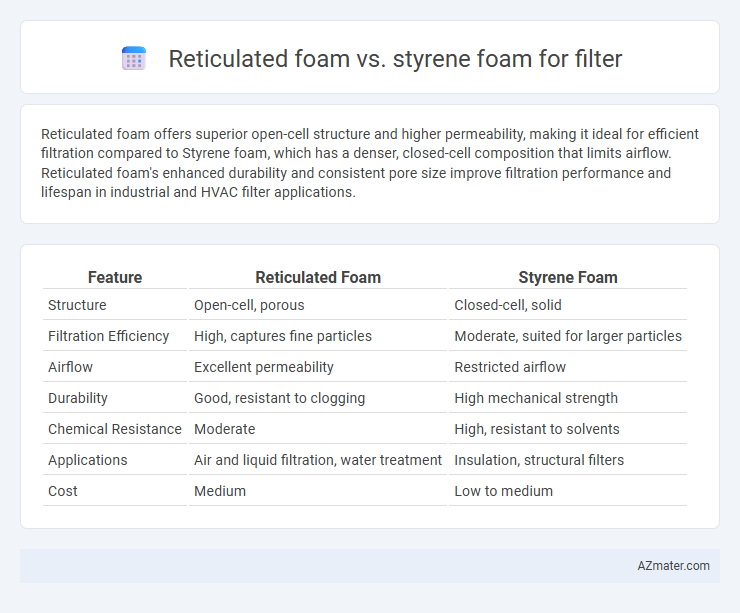Reticulated foam offers superior open-cell structure and higher permeability, making it ideal for efficient filtration compared to Styrene foam, which has a denser, closed-cell composition that limits airflow. Reticulated foam's enhanced durability and consistent pore size improve filtration performance and lifespan in industrial and HVAC filter applications.
Table of Comparison
| Feature | Reticulated Foam | Styrene Foam |
|---|---|---|
| Structure | Open-cell, porous | Closed-cell, solid |
| Filtration Efficiency | High, captures fine particles | Moderate, suited for larger particles |
| Airflow | Excellent permeability | Restricted airflow |
| Durability | Good, resistant to clogging | High mechanical strength |
| Chemical Resistance | Moderate | High, resistant to solvents |
| Applications | Air and liquid filtration, water treatment | Insulation, structural filters |
| Cost | Medium | Low to medium |
Introduction: Reticulated Foam vs Styrene Foam for Filter Applications
Reticulated foam offers high permeability and open-cell structure, making it ideal for efficient air and liquid filtration by allowing contaminants to pass through while trapping debris. Styrene foam, characterized by closed-cell structure, provides rigidity and thermal insulation but limits fluid flow, reducing its effectiveness in filter applications. Choosing between reticulated foam and styrene foam depends on the required filtration efficiency and flow rate for specific industrial or environmental filtration needs.
Composition and Structure of Reticulated Foam
Reticulated foam is composed of a polyurethane or polyester open-cell matrix with a network of interconnected pores, allowing superior airflow and particle filtration compared to the closed-cell Styrene foam. Its structure is characterized by the complete removal of cell faces, creating a skeletal lattice that enhances durability and efficiency in capturing contaminants. This composition makes reticulated foam highly effective in applications requiring high permeability and consistent filtration performance.
Composition and Structure of Styrene Foam
Styrene foam, also known as expanded polystyrene (EPS), consists of rigid beads of polystyrene polymer fused together, forming a closed-cell structure that provides excellent insulation and moisture resistance. Its closed-cell composition makes it less permeable and more rigid compared to reticulated foam, which features an open-cell, skeletal network primarily made of polyurethane. This structural difference results in styrene foam's superior compressive strength and durability in filtration applications requiring moisture barrier properties and structural integrity.
Key Differences in Filtration Efficiency
Reticulated foam exhibits higher filtration efficiency than styrene foam due to its open-cell structure that allows for superior airflow and particle capture, especially in applications requiring fine dust and liquid filtration. Styrene foam, with a closed-cell configuration, offers lower filtration performance but excels in applications focusing on insulation and cushioning rather than detailed filtration. In industrial and environmental filtration systems, reticulated foam is preferred for optimized contaminant removal and enhanced durability under varied operating conditions.
Durability and Lifespan Comparison
Reticulated foam offers superior durability and a longer lifespan compared to styrene foam due to its open-cell structure that resists clogging and maintains airflow efficiency over extended use. Styrene foam, while lightweight and cost-effective, tends to degrade faster under mechanical stress and environmental exposure, leading to reduced filtration performance. The enhanced resilience of reticulated foam makes it ideal for repeated cleaning and harsh filtration environments, ensuring consistent filter function and longevity.
Pore Size and Airflow Characteristics
Reticulated foam offers a uniform pore size, typically ranging from 20 to 60 pores per inch (PPI), enabling superior airflow and efficient particulate filtration. Styrene foam generally features larger, less consistent pores, resulting in reduced airflow and lower filtration precision compared to reticulated foam. For filter applications requiring balanced air permeability and fine particle capture, reticulated foam provides optimized performance due to its controlled porosity and high open-cell structure.
Chemical Resistance and Compatibility
Reticulated foam offers superior chemical resistance to a wide range of solvents, oils, and acids compared to Styrene foam, making it ideal for filtration applications involving aggressive chemicals. Styrene foam, while cost-effective, demonstrates limited compatibility with many organic solvents and can degrade when exposed to harsh chemicals. Selecting Reticulated foam ensures enhanced durability and longer service life in chemically demanding filtration environments.
Environmental Impact and Recyclability
Reticulated foam, made from polyurethane, offers superior recyclability through mechanical and chemical processes, reducing landfill waste compared to styrene foam, which is a type of expanded polystyrene (EPS) recognized for its limited recyclability and persistence in the environment. The environmental impact of reticulated foam is lower due to its biodegradable potential and less harmful chemical composition, whereas styrene foam contributes significantly to pollution and poses challenges in waste management because of its non-biodegradable nature and tendency to fragment into microplastics. Choosing reticulated foam for filters supports sustainable practices by enabling material recovery and minimizing ecological footprint, unlike styrene foam that often leads to increased environmental contamination and resource depletion.
Cost Analysis and Affordability
Reticulated foam offers superior filtration efficiency but comes at a higher price point compared to styrene foam, impacting overall project budgets. Styrene foam's lower material and production costs make it a more affordable option for large-scale or cost-sensitive filtration applications. Cost analysis reveals that while reticulated foam delivers better performance, styrene foam provides a budget-friendly balance between price and acceptable filtration quality.
Choosing the Right Foam: Application-Based Recommendations
Reticulated foam offers superior air and liquid flow due to its open-cell structure, making it ideal for applications requiring high filtration efficiency such as pool filters and HVAC systems. Styrene foam, characterized by closed-cell bubbles, provides better structural rigidity and moisture resistance, suitable for applications demanding durability and thermal insulation like packaging filters or soundproofing. Selecting between reticulated and styrene foam depends on balancing filtration performance with mechanical strength based on the specific operational environment and fluid type.

Infographic: Reticulated foam vs Styrene foam for Filter
 azmater.com
azmater.com